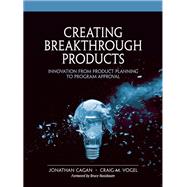
JONATHAN CAGAN is a Professor of Mechanical Engineering at Carnegie Mellon University. His work focuses on the early stages of product development with emphasis on engineering design, interdisciplinary collaborations, formal design synthesis, and computational design tools. Dr. Cagan is a Fellow of the American Society of Mechanical Engineers and a registered Professional Engineer.
CRAIG M. VOGEL is a Professor in the School of Design at Carnegie Mellon University. His areas of expertise include product design, product aesthetics, design history, team management, and design patent litigation. Professor Vogel is a Fellow, and former President, of the Industrial Designers Society of America (IDSA).
Professors Cagan and Vogel have collaborated for close to a decade in teaching, research, and consulting in the area of integrated new product development. For more information see www.creatingbreakthroughproducts.com
The New copy of this book will include any supplemental materials advertised. Please check the title of the book to determine if it should include any access cards, study guides, lab manuals, CDs, etc.
The Used, Rental and eBook copies of this book are not guaranteed to include any supplemental materials. Typically, only the book itself is included. This is true even if the title states it includes any access cards, study guides, lab manuals, CDs, etc.